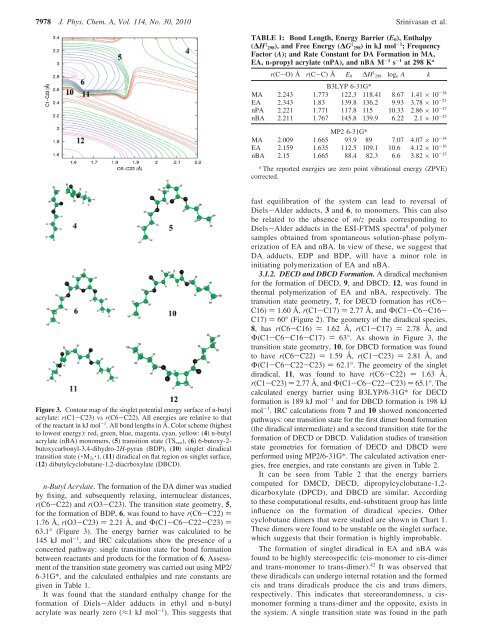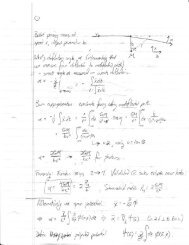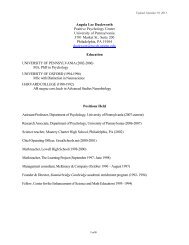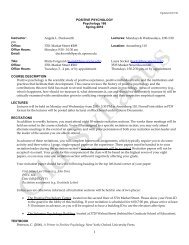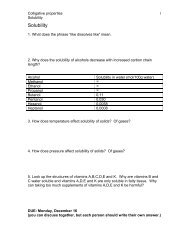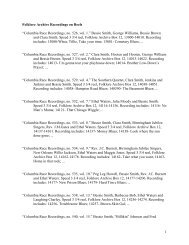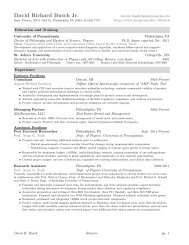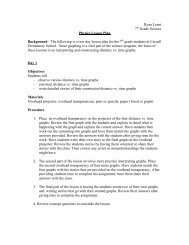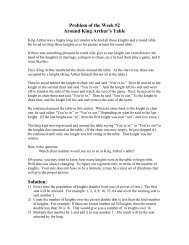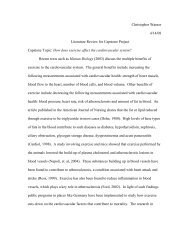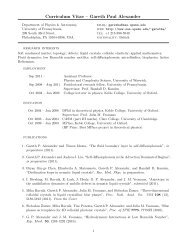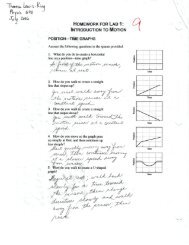Self-Initiation Mechanism in Spontaneous Thermal Polymerization of ...
Self-Initiation Mechanism in Spontaneous Thermal Polymerization of ...
Self-Initiation Mechanism in Spontaneous Thermal Polymerization of ...
You also want an ePaper? Increase the reach of your titles
YUMPU automatically turns print PDFs into web optimized ePapers that Google loves.
7978 J. Phys. Chem. A, Vol. 114, No. 30, 2010 Sr<strong>in</strong>ivasan et al.<br />
TABLE 1: Bond Length, Energy Barrier (E 0 ), Enthalpy<br />
(∆H ‡ 298), and Free Energy (∆G ‡ 298) <strong>in</strong>kJmol -1 ; Frequency<br />
Factor (A); and Rate Constant for DA Formation <strong>in</strong> MA,<br />
EA, n-propyl acrylate (nPA), and nBA M -1 s -1 at 298 K a<br />
r(C-O) Å r(C-C) Å E 0 ∆H ‡ 298 log e A k<br />
B3LYP 6-31G*<br />
MA 2.243 1.773 122.3 118.41 8.67 1.41 × 10 -18<br />
EA 2.343 1.83 139.8 136.2 9.93 3.78 × 10 -21<br />
nPA 2.221 1.771 117.8 115 10.33 2.86 × 10 -17<br />
nBA 2.211 1.767 145.8 139.9 6.22 2.1 × 10 -23<br />
MP2 6-31G*<br />
MA 2.009 1.665 93.9 89 7.07 4.07 × 10 -14<br />
EA 2.159 1.635 112.5 109.1 10.6 4.12 × 10 -16<br />
nBA 2.15 1.665 88.4 82.3 6.6 3.82 × 10 -13<br />
a The reported energies are zero po<strong>in</strong>t vibrational energy (ZPVE)<br />
corrected.<br />
Figure 3. Contour map <strong>of</strong> the s<strong>in</strong>glet potential energy surface <strong>of</strong> n-butyl<br />
acrylate: r(C1-C23) vs r(C6-C22). All energies are relative to that<br />
<strong>of</strong> the reactant <strong>in</strong> kJ mol -1 . All bond lengths <strong>in</strong> Å. Color scheme (highest<br />
to lowest energy): red, green, blue, magenta, cyan, yellow: (4) n-butyl<br />
acrylate (nBA) monomers, (5) transition state (TS exo ), (6) 6-butoxy-2-<br />
butoxycarbonyl-3,4-dihydro-2H-pyran (BDP), (10) s<strong>in</strong>glet diradical<br />
transition state ( · M 2s · ), (11) diradical on flat region on s<strong>in</strong>glet surface,<br />
(12) dibutylcyclobutane-1,2-diacrboxylate (DBCD).<br />
n-Butyl Acrylate. The formation <strong>of</strong> the DA dimer was studied<br />
by fix<strong>in</strong>g, and subsequently relax<strong>in</strong>g, <strong>in</strong>ternuclear distances,<br />
r(C6-C22) and r(O3-C23). The transition state geometry, 5,<br />
for the formation <strong>of</strong> BDP, 6, was found to have r(C6-C22) )<br />
1.76 Å, r(O3-C23) ) 2.21 Å, and Φ(C1-C6-C22-C23) )<br />
63.1° (Figure 3). The energy barrier was calculated to be<br />
145 kJ mol -1 , and IRC calculations show the presence <strong>of</strong> a<br />
concerted pathway: s<strong>in</strong>gle transition state for bond formation<br />
between reactants and products for the formation <strong>of</strong> 6. Assessment<br />
<strong>of</strong> the transition state geometry was carried out us<strong>in</strong>g MP2/<br />
6-31G*, and the calculated enthalpies and rate constants are<br />
given <strong>in</strong> Table 1.<br />
It was found that the standard enthalpy change for the<br />
formation <strong>of</strong> Diels-Alder adducts <strong>in</strong> ethyl and n-butyl<br />
acrylate was nearly zero (≈1 kJmol -1 ). This suggests that<br />
fast equilibration <strong>of</strong> the system can lead to reversal <strong>of</strong><br />
Diels-Alder adducts, 3 and 6, to monomers. This can also<br />
be related to the absence <strong>of</strong> m/z peaks correspond<strong>in</strong>g to<br />
Diels-Alder adducts <strong>in</strong> the ESI-FTMS spectra 8 <strong>of</strong> polymer<br />
samples obta<strong>in</strong>ed from spontaneous solution-phase polymerization<br />
<strong>of</strong> EA and nBA. In view <strong>of</strong> these, we suggest that<br />
DA adducts, EDP and BDP, will have a m<strong>in</strong>or role <strong>in</strong><br />
<strong>in</strong>itiat<strong>in</strong>g polymerization <strong>of</strong> EA and nBA.<br />
3.1.2. DECD and DBCD Formation. A diradical mechanism<br />
for the formation <strong>of</strong> DECD, 9, and DBCD, 12, was found <strong>in</strong><br />
thermal polymerization <strong>of</strong> EA and nBA, respectively. The<br />
transition state geometry, 7, for DECD formation has r(C6-<br />
C16) ) 1.60 Å, r(C1-C17) ) 2.77 Å, and Φ(C1-C6-C16-<br />
C17) ) 60° (Figure 2). The geometry <strong>of</strong> the diradical species,<br />
8, has r(C6-C16) ) 1.62 Å, r(C1-C17) ) 2.78 Å, and<br />
Φ(C1-C6-C16-C17) ) 63°. As shown <strong>in</strong> Figure 3, the<br />
transition state geometry, 10, for DBCD formation was found<br />
to have r(C6-C22) ) 1.59 Å, r(C1-C23) ) 2.81 Å, and<br />
Φ(C1-C6-C22-C23) ) 62.1°. The geometry <strong>of</strong> the s<strong>in</strong>glet<br />
diradical, 11, was found to have r(C6-C22) ) 1.63 Å,<br />
r(C1-C23) ) 2.77 Å, and Φ(C1-C6-C22-C23) ) 65.1°. The<br />
calculated energy barrier us<strong>in</strong>g B3LYP/6-31G* for DECD<br />
formation is 189 kJ mol -1 and for DBCD formation is 198 kJ<br />
mol -1 . IRC calculations from 7 and 10 showed nonconcerted<br />
pathways: one transition state for the first dimer bond formation<br />
(the diradical <strong>in</strong>termediate) and a second transition state for the<br />
formation <strong>of</strong> DECD or DBCD. Validation studies <strong>of</strong> transition<br />
state geometries for formation <strong>of</strong> DECD and DBCD were<br />
performed us<strong>in</strong>g MP2/6-31G*. The calculated activation energies,<br />
free energies, and rate constants are given <strong>in</strong> Table 2.<br />
It can be seen from Table 2 that the energy barriers<br />
computed for DMCD, DECD, dipropylcyclobutane-1,2-<br />
dicarboxylate (DPCD), and DBCD are similar. Accord<strong>in</strong>g<br />
to these computational results, end-substituent group has little<br />
<strong>in</strong>fluence on the formation <strong>of</strong> diradical species. Other<br />
cyclobutane dimers that were studied are shown <strong>in</strong> Chart 1.<br />
These dimers were found to be unstable on the s<strong>in</strong>glet surface,<br />
which suggests that their formation is highly improbable.<br />
The formation <strong>of</strong> s<strong>in</strong>glet diradical <strong>in</strong> EA and nBA was<br />
found to be highly stereospecific (cis-monomer to cis-dimer<br />
and trans-monomer to trans-dimer). 42 It was observed that<br />
these diradicals can undergo <strong>in</strong>ternal rotation and the formed<br />
cis and trans diradicals produce the cis and trans dimers,<br />
respectively. This <strong>in</strong>dicates that stereorandomness, a cismonomer<br />
form<strong>in</strong>g a trans-dimer and the opposite, exists <strong>in</strong><br />
the system. A s<strong>in</strong>gle transition state was found <strong>in</strong> the path


